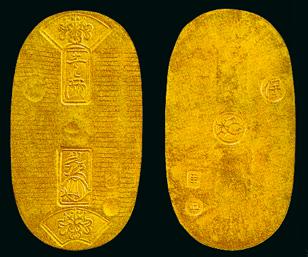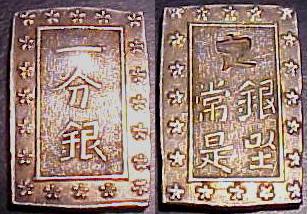Japanese Coins |
Commodore Perry was very interested in obtaining coins in Lew Chew.
He made a specific and personal effort to obtain the local Okinawan currency. His effort was fruitless and in the Narrative it is noted:
The Lew Chewans always insisted that they had no current coin, and that they had no national currency; and, though they were very much in the habit, for motives of supposed policy, of exaggerating their poverty, this statement is probably true. (page 227, Volume 1, Narrative).In Commodore Perry's Personal Journal he stated: At this visit I informed the regent that I was desirous of obtaining for the United States Mint, in exchange for pieces of American coinage of equal value, all coins in use in the island, well knowing that the imperial coins of Japan were in circulation, though they had hitherto concealed them from us.While Perry contended in his personal journal that he wanted the coins for the Government, in all probablility he wanted some for his personal coin collection. Commodore Perry was a numismatist. At his death the collection was passed to his daughter (Caroline Slidell Perry (Belmont)). The collection was maintained and passed down through the family. Finally in January of 1995, over 200 after his birth, the Commodore Perry Collection (coin) was offered at public auction by the auction firm of Bowers and Merena, Inc.  Bowers and Merena Auctions Many of the coins offered in this sale were probably acquired by Perry in his travels, as certain dates of world coins in the collection coincide with visits by the Commodore to those countries, particularly the coins of Japan, where Perry visited in 1853-4. (p 21)There were 12 Japanese coin lots in the auction. The were predominately the gold and silver Ichibu coins (see below for example of a silver Ichibu coin) from the time period of the visit to Japan. |
Coins in Circulation in Japan and Okinawa |
|
Japanese Coins At the top are the types of gold and silver coins in circulation at the time of Perry's Expedition. They are called the Japan Tempo Koban Kin (Gold) and the Ko Bu-Gin (Silver). These coins were issued during the Tempo era (1837-1854) prior to the modern coinage era of Meiji. The Ko 1 Bu-Gin silver coin was quite pure (.991 silver) and weighed 8.66 grams. Due to the different gold-silver ratio in the rest of the world the silver Bu coins were the cause of a major gold exodus from Japan and created quite a problem. Three of the 1 Bu pieces were set at one 8 Reale piece which was the predominate circulating coin during this era. Traders would trade the 8 Reale pieces for three 1 Bu silver coins and then exchange the silver coins for gold coins. The Japenese silver coins were in effect causing a gold drain as the foreignors figured the situation out. Reduced to it's simplist terms, the Ko Bu-Gin (silver coin) was over-valued by the Japanese in relation to the Koban Kin (gold coin). A British commentator of the time (early 1860s), Sir Rutherford Alcock, stated it in this way: By careful assay at the British Mint, it was subsequently found that silver coins in the currency of Japan, bore the relation of hardly five to one with the gold, and were overvalued therefore to the extent of two thirds, above the average proportion (viz. fifteen and a half to one), which silver bullion bears to gold in relation to the general market of the world. The Capital of the Tycoon: A Narrative of a Three Years' Residence in Japan, Sir Rutherford Alcock, at page 411. Ryukyuan coins were not issued until 1862 (shown above). Counterfeits of the Ryukyan coins exist. It is said that the gunine Ryukyu Tsuho (To-Hyaku) coins bear a mint mark of the katakana syllabic "sa" Less than 100 years after Perry's visit, the US military government instituted a unique Okinawan currency (B-Yen notes, no coins) through the Government of the Ryukyu Islands which remained in place until 1958 when US currency became the legal tender in the Ryukyus.
(1945-1958) 
The US dollar remained the legal tender in the Ryukyu Islands until reversion back to Japan in 1972. |




